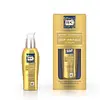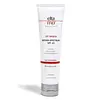What's inside
What's inside
 Key Ingredients
Key Ingredients

 Benefits
Benefits

 Concerns
Concerns

 Ingredients Side-by-side
Ingredients Side-by-side

Water
Skin ConditioningCyclopentasiloxane
EmollientGlycerin
HumectantTetrahydroxypropyl Ethylenediamine
Dimethicone Crosspolymer
Emulsion StabilisingDimethicone
EmollientAmmonium Acryloyldimethyltaurate/Vp Copolymer
Nylon-12
PEG-12 Dimethicone
Skin ConditioningTocopherol
AntioxidantPhenoxyethanol
PreservativeCitric Acid
BufferingButylene Glycol
HumectantPentylene Glycol
Skin ConditioningLaureth-23
CleansingHydrolyzed Wheat Protein
Skin ConditioningParfum
MaskingLaureth-4
EmulsifyingMethylparaben
PreservativePropylparaben
PreservativeDisodium EDTA
Alanine
MaskingBHT
AntioxidantHelianthus Annuus Seed Oil
EmollientC13-14 Isoparaffin
EmollientPolysorbate 20
EmulsifyingMagnesium Aspartate
Skin ConditioningZinc Gluconate
Skin ConditioningBisabolol
MaskingRetinol
Skin ConditioningAscorbic Acid
AntioxidantLaureth-7
EmulsifyingCopper Gluconate
Skin ConditioningCI 19140
Cosmetic ColorantWater, Cyclopentasiloxane, Glycerin, Tetrahydroxypropyl Ethylenediamine, Dimethicone Crosspolymer, Dimethicone, Ammonium Acryloyldimethyltaurate/Vp Copolymer, Nylon-12, PEG-12 Dimethicone, Tocopherol, Phenoxyethanol, Citric Acid, Butylene Glycol, Pentylene Glycol, Laureth-23, Hydrolyzed Wheat Protein, Parfum, Laureth-4, Methylparaben, Propylparaben, Disodium EDTA, Alanine, BHT, Helianthus Annuus Seed Oil, C13-14 Isoparaffin, Polysorbate 20, Magnesium Aspartate, Zinc Gluconate, Bisabolol, Retinol, Ascorbic Acid, Laureth-7, Copper Gluconate, CI 19140
Zinc Oxide 9%
Cosmetic ColorantEthylhexyl Methoxycinnamate 7.5%
UV AbsorberWater
Skin ConditioningIsopropyl Palmitate
EmollientEthylhexyl Stearate
EmollientCetearyl Alcohol
EmollientPolysorbate 60
EmulsifyingOleth-3 Phosphate
Phenoxyethanol
PreservativeCetearyl Glucoside
EmulsifyingHydroxyethyl Acrylate/Sodium Acryloyldimethyl Taurate Copolymer
Emulsion StabilisingPolyisobutene
Polyether-1
Butylene Glycol
HumectantPEG-7 Trimethylolpropane Coconut Ether
EmulsifyingTocopheryl Acetate
AntioxidantCitric Acid
BufferingIodopropynyl Butylcarbamate
PreservativeTriethoxycaprylylsilane
Zinc Oxide 9%, Ethylhexyl Methoxycinnamate 7.5%, Water, Isopropyl Palmitate, Ethylhexyl Stearate, Cetearyl Alcohol, Polysorbate 60, Oleth-3 Phosphate, Phenoxyethanol, Cetearyl Glucoside, Hydroxyethyl Acrylate/Sodium Acryloyldimethyl Taurate Copolymer, Polyisobutene, Polyether-1, Butylene Glycol, PEG-7 Trimethylolpropane Coconut Ether, Tocopheryl Acetate, Citric Acid, Iodopropynyl Butylcarbamate, Triethoxycaprylylsilane
 Reviews
Reviews

Ingredients Explained
These ingredients are found in both products.
Ingredients higher up in an ingredient list are typically present in a larger amount.
Butylene Glycol (or BG) is used within cosmetic products for a few different reasons:
Overall, Butylene Glycol is a safe and well-rounded ingredient that works well with other ingredients.
Though this ingredient works well with most skin types, some people with sensitive skin may experience a reaction such as allergic rashes, closed comedones, or itchiness.
Learn more about Butylene GlycolCitric Acid is an alpha hydroxy acid (AHA) naturally found in citrus fruits like oranges, lemons, and limes.
Like other AHAs, citric acid can exfoliate skin by breaking down the bonds that hold dead skin cells together. This helps reveal smoother and brighter skin underneath.
However, this exfoliating effect only happens at high concentrations (20%) which can be hard to find in cosmetic products.
Due to this, citric acid is usually included in small amounts as a pH adjuster. This helps keep products slightly more acidic and compatible with skin's natural pH.
In skincare formulas, citric acid can:
While it can provide some skin benefits, research shows lactic acid and glycolic acid are generally more effective and less irritating exfoliants.
Most citric acid used in skincare today is made by fermenting sugars (usually from molasses). This synthetic version is identical to the natural citrus form but easier to stabilize and use in formulations.
Read more about some other popular AHA's here:
Learn more about Citric AcidPhenoxyethanol is a preservative that has germicide, antimicrobial, and aromatic properties. Studies show that phenoxyethanol can prevent microbial growth. By itself, it has a scent that is similar to that of a rose.
It's often used in formulations along with Caprylyl Glycol to preserve the shelf life of products.
Water. It's the most common cosmetic ingredient of all. You'll usually see it at the top of ingredient lists, meaning that it makes up the largest part of the product.
So why is it so popular? Water most often acts as a solvent - this means that it helps dissolve other ingredients into the formulation.
You'll also recognize water as that liquid we all need to stay alive. If you see this, drink a glass of water. Stay hydrated!
Learn more about Water